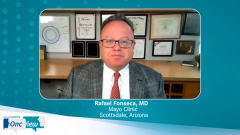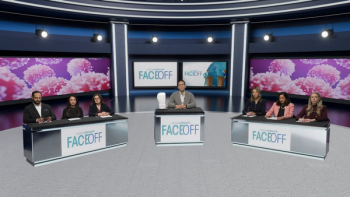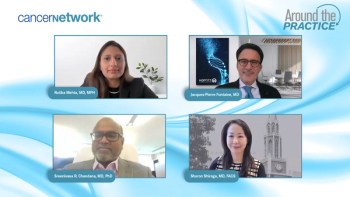
Depth of Response and Treatment Duration in Newly Diagnosed MM
Depth of response and treatment duration in patients with newly diagnosed MM are discussed by Dr Fonseca.
Episodes in this series

Rafael Fonseca, MD: While we have criteria that allows us to categorize the depth of the response for myeloma patients, we are learning that criteria perhaps in time will become more of an academic exercise. We want patients who are going to go through transplant - and that is before transplant and certainly after transplant - to achieve very deep responses and in the post-transplant period to achieve MRD negativity. So, we all see patients that are referred to the transplant centers who may have initiated on a regimen. Perhaps sometimes even a 3-drug regimen that may have, what I would say, is of optimal response. They're going into transplant with a partial response.
Well, 10 years ago, it was perfectly fine to move forward. I would suggest that those patients need to derive better disease control from an alternative combination before they proceed to transplant. For two reasons, the depth of the response seems to correlate with long-term outcomes but also there's a potential and some of you might point out this hypothetical. But there is a potential for contamination of the product or residual cells post stem cell transplant. So, I think we want to have patients go into transplant and certainly come out of transplant with the best response as possible.
In our clinical practice for patients who will go through the stem cell transplant, we do a very thorough assessment, post-stem cell transplant to determine what the next steps would be. And sometimes we have offered consolidation for patients who are still MRD positive post-stem cell transplant with an understanding that those pathways may vary according to the genetic subtype of the disease. But certainly, there's good evidence that for patients with high-risk disease leaving cells behind is associated with a very high risk of early relapse. Now whether one does that or not, the next step is of course maintenance and maintenance is supported by several randomized trials as well as a meta-analysis that shows that as of now maintenance with Lenalidomide is the standard of care. There are other studies that are exploring different maintenance strategies the use of Carfilzomib, for instance the FORTE [trial], the use of daratumumab as is being explored in the AURIGAclinical trial.
The reality is that most patients benefit from what we know today for longer duration of therapy. Our patients are going to maintenance do so with the understanding that as long as they tolerate the treatment and they have access to the treatment and assuming it's working, that is we're not seeing evidence of a disease recurrence, we will keep those patients going on that maintenance treatment. Now the reality is that the real-world evidence available from the United States suggests that most patients don't go beyond 2 years. The reasons for this are multiple but certainly a component of that is toxicity so patients having fatigue, having chronic diarrhea. I would say to patients yes, we're going to start maintenance that rather go for a longer period of time, but I understand that many patients have to stop treatment because of the symptomatology that will interfere with their quality of life.
Now we're all hoping for a future, and hopefully not too distant future, where the availability of information regarding MRD information would allow us to confidently and without other considerations stop therapy. So now we stop therapy for multiple reasons. I bring the MRD information into the bedside as we make those decisions, but there might be a more clear future where MRD itself dictates who can continue in therapy and who can stop.
A legitimate question is what will happen in the future regarding stem cell transplant for those patients that are eligible and there are many possibilities. One of them is that transplant will remain as an important step in consolidating that initial gain of induction therapy and that perhaps will build on that. We will address residual disease through novel strategies. It could include molecularly targeted strategies like Venetoclax for t(11;14) patients or immunology strategies such as could be bispecific antibodies or CAR T-cells.
There are other possibilities as well and one of the tantalizing one is that transplant might not be needed and while transplant has been very effective, it does carry a burden of symptoms. And the time away from work, from family, the hair loss, all those things. So perhaps, we will see induction therapy in other ways followed by either a CAR T-cell or one of the bispecifics, and why not? Perhaps even think of a chemotherapy free regimen that could be a bispecific plus a targeted agent that results in very significant cytoreduction and avoids the need of oculating [ph] agents. But again, this is all in in flux, evolving and being addressed through multiple clinical trials.
Transcript edited for clarity.
Newsletter
Stay up to date on recent advances in the multidisciplinary approach to cancer.































































































